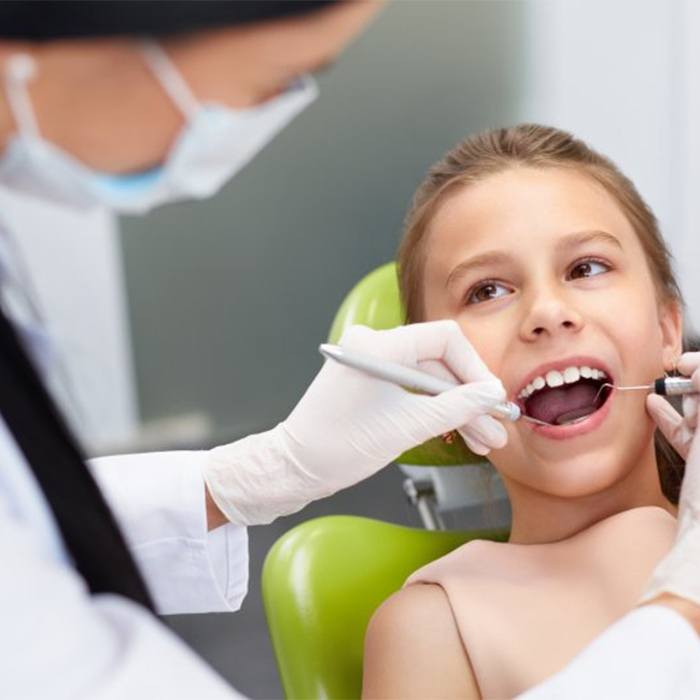
Tooth Extraction – Duncanville, TX
Ensuring Your Child’s Comfort Throughout Treatment
The dentists at Barefield Pediatric Dentistry rarely consider tooth extraction to be their first treatment consideration when your child is dealing with severe tooth decay, an oral injury, or other problematic situation regarding their teeth. Even if a tooth does need to be removed, we take every step necessary to make them feel comfortable, keep them at ease, and ensure a speedy recovery immediately afterwards. After all, our pediatric dentists are experts when it comes to helping children complete the care they need. Call our office if you need a dentist who will take the time to ensure your child’s comfort, no matter what.

When is an Extraction Needed?

Tooth extraction is typically needed when a tooth has sustained so much damage that it can no longer survive inside the jaw. For example, if your child’s tooth has severe decay, it’s possible that no restoration or amount of therapy can restore it. Furthermore, if your child was playing a contact sport without a mouthguard and their tooth became severely cracked, it may not be viable if the crack extends below the gum line. Additionally, if a baby tooth is not falling out properly and a permanent tooth is erupting, we can remove the baby tooth to make room. No matter what the circumstance, we’ll make sure that you know exactly why treatment is necessary and make your child feel comfortable from start to finish.
What Does Treatment Entail?

Before we get started, we administer a local anesthetic to the tooth and the surrounding area to ensure no feeling is present before extraction. If your child requires sedation in order to get comfortable, we offer all levels of sedation dentistry, including sedation only found in hospitals for those with special needs or extreme dental anxiety. Most children note that because of the local anesthetics, they hardly feel a thing during the majority of treatment. After gently rocking the tooth back and forth, one of our caring dentists will remove the tooth, then ask your child to bite down onto a gauze pad so the socket can properly begin healing.
What Does Aftercare Look Like?

The socket typically takes about three to four days to heal. During this time, swelling may also be present, but this should begin to go away after the fifth day of healing. After about two weeks, you’ll come back to our office so we can confirm that healing is occurring properly.
To speed up the healing process and avoid complications, make sure to:
- Protect the open socket
- Avoid disturbing the blood clot
- Advise them to avoid rinsing their mouth out for the next 24 hours
- Advise them to avoid drinking through a straw for the next 24 hours
- Gently rinse their mouth out with a saltwater mixture to promote healing on the second day after treatment
- Gently brush their teeth on the third day, making sure they do not spit vigorously
- Keep to a soft diet and avoid chewing on the side of the mouth where the extraction site is located
Understanding the Cost of Tooth Extractions

Learning your child needs to have one or more teeth extracted can be a lot to process. Apart from grasping the reality that they need this kind of procedure, you might also be wondering about the cost. When formulating an estimate for tooth extraction, it’s important that Dr. Barefield and our team consider all the different factors, as each case is different. Because of this, there is no set price for this procedure. However, you can expect that our team will make every effort to help keep out-of-pocket costs low as well as discuss ways to maximize any available benefits you might have.
Factors That Can Affect Tooth Extraction Cost
The cost of tooth extraction cannot be determined until you bring your child in for an appointment. We will need to examine their mouth and compile the necessary information to not only build a treatment plan but as a cost estimate. The factors you can expect us to consider include:
- The type of tooth that needs to be extracted
- Where the tooth is located inside the mouth
- Whether it is only one tooth that needs to be removed or several
- Whether they will require a simple or surgical procedure
- How we plan to address the space after the tooth is removed
Does Dental Insurance Cover Tooth Extractions?
Tooth extractions are usually covered by dental insurance. Most companies view them as medically necessary, so depending on how they categorize this type of procedure, your insurer may agree to cover 50-80% of the total price tag. It is essential, though, that you first meet your deductible before they will agree to pay more. You can trust that our team at Barefield Pediatric Dentistry will help address the details associated with your child’s coverage as well as file any necessary paperwork so that you can help your little one stay focused on improving the state of their oral health.
Other Options for Making Tooth Extractions Affordable
Dr. Barefield and our team want to make sure that all patients can afford necessary oral healthcare, which is why we partner with CareCredit. If your child is without dental insurance, you can enroll in a low-interest financing plan that allows you to remain within your budget while paying off your child’s treatment. As long as you qualify, you’ll be able to make monthly payments without the added stress.
Tooth Extractions for Kids FAQs
Is there an alternative for a tooth extraction for kids?
Our team at Barefield Pediatric Dentistry will never recommend a tooth extraction for a child unless we feel it’s absolutely necessary to maintain and preserve a healthy smile. In many cases, this is our best option when we fear that leaving a severely damaged or infected tooth within a mouth will lead to more or worse issues developing as a result.
What’s the recovery process for a tooth extraction for kids like?
Your child will likely feel sore and groggy after their tooth extraction, especially if they receive dental sedation. Because of this, our team recommends giving them one to two days off of school to recover. In addition to resting, it’s important to make sure that your child’s blood clot stays intact to promote a complication-free recovery. In order to do this, we recommend not letting your child spit or drink through a straw, and encourage them to eat a soft diet.
Throughout their recovery, you’ll also want to keep your child’s mouth clean to minimize the risk of developing an infection. If they’re old enough to rinse their mouth, have them rinse with salt water. Be sure to continue brushing their teeth and flossing as well, being sure to avoid the extraction site. Your child should begin feeling much better by the third day after their procedure, but in some cases, it may be even sooner!
Is it okay to leave a space after a children’s tooth extraction?
If your child had to have a temporary tooth extracted, we may recommend a space maintainer. This serves to help maintain their dental alignment by leaving space for their permanent tooth that was located underneath their extracted temporary tooth to grow in.
How can I help speed up the healing time after my child had a tooth extracted?
Following your child’s tooth extraction, a good way to help them make a fast recovery is to allow them ample time to rest and help them avoid strenuous activity for the first 24 hours. You’ll also want to keep their head elevated above their heart and avoid foods and drinks that may cause irritation to the extraction site, like acidic foods, gummies, etc.
How should I prepare my child for their tooth extraction?
In many cases, our pediatric dentists in Duncanville will help you find gentle, encouraging words to share with your child in the days following up to their procedure in case they ask you questions. We encourage being positive and not going into too much detail, especially if you feel unsure of what to say! Before their treatment, our pediatric dentists will allow time for them to ask any questions and yourself as well, making sure everyone feels comfortable and at-ease. If you have any concerns, never hesitate to give our team a call!